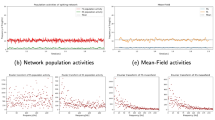The effects of electrical stimulation of the oral reticular nucleus of the pons on behavior and brain activity in different states of the sleep–waking cycle were studied in Krushinskii–Molodkina rats, which have an inherited predisposition to audiogenic convulsions. Electrical stimulation of this structure at a frequency of 7 Hz on the background of deep slow-wave sleep induced a transition from slow- to fast-wave sleep. Analogous stimulation during fast-wave sleep had no effect on the electrogram patterns or spectra of the hippocampus or the visual, auditory, or somatosensory areas of the cortex and did not interrupt this state, though it did induce an almost twofold increase in the duration of its individual episodes. Electrical stimulation of the nucleus at 7 Hz during waking or shallow slow-wave sleep had no effect on behavior or electrogram patterns or spectral characteristics in the study structures and did not induce transition from one stage of the cycle to another. The results obtained here show that the state of the animals in the sleep–waking cycle is an important variable on which the effects of electrical stimulation of the oral reticular nucleus of the pons depend.
Similar content being viewed by others
References
S. I. Vataev, N. A. Mal’gina, and G. A. Oganesyan, “Effects of stimulation of the inferior colliculi in Krushinskii–Molodkina rats,” Ros. Fiziol. Zh., 100, No. 6, 699–709 (2014).
S. I. Vataev, G. A. Oganesyan, A. V. Klimash, and E. N. Kondakov, “Effects of transliquor electrical stimulation of the brain on the background of different states in the sleep–waking cycle in rats,” Ros. Fiziol. Zh., 95, No. 6, 601–609 (2009).
O. Yu. Dergacheva, I. E. Khachikova, and A. A. Burikov, “Dynamics of neuron spike activity in the oral nucleus of the pons in the sleep–waking cycle in cats,” Ros. Fiziol. Zh., 88, No. 12, 1530–1537 (2002).
I. G. Karmanova, The Evolution of Sleep. Stages in the Formation of the Sleep–Waking Cycle in Various Vertebrates, Nauka, Leningrad (1977).
I. G. Karmanova, V. F. Maksimuk, A. N. Panov, et al., “The role of the paradoxical phase in the organization of the sleep–waking cycle in rats,” Fiziol. Zh. SSSR, 64, No. 8, 1074–1081 (1978).
I. G. Karmanova and G. A. Oganesyan, Physiology and Pathology of the Sleep–Waking Cycle, Evolutionary Aspects, Nauka, St. Petersburg (1994).
I. G. Karmanova, O. E. Khomutetskaya, and N. V. Shilling, “Comparative physiological analysis of the stages of the evolution of sleep and the mechanisms of its regulation,” Usp. Fiziol. Nauk., 12, No. 2, 3–20 (1981).
P. Bourgin, P. Escourrou, C. Gaultier, and J. Adrien, “Induction of rapid eye movement sleep by carbachol infusion into the pontine reticular formation in the rat,” Neuroreport, 6, No. 3, 532–536 (1995).
R. A. Browning, D. K. Nelson, N. Mogharreban, et al., “Effect of midbrain and pontine tegmental lesions on audiogenic seizures in genetically epilepsy-prone rats,” Epilepsia, 26, No. 2, 175–183 (1985).
S. Datta, E. E. Spoley, and E. H. Patterson, “Microinjection of glutamate into the pedunculopontine tegmentum induces REM sleep and wakefulness in the rat,” Am. J. Physiol. Regul. Integrat. Comp. Physiol., 280, No. 3, 752–759 (2001).
C. L. Faingold, “Neuronal networks in the genetically epilepsy-prone rat,” Adv. Neurol., 79, 311–321 (1999).
C. L. Faingold, “Brainstem networks: reticulo-cortical synchronization in generalized convulsive seizures,” in: Jasper’s Basic Mechanisms of the Epilepsies [Internet], J. L. Noebels et al. (eds.), National Center for Biotechnology Information (US), Bethesda, MD (2012).
C. L. Faingold and M. E. Randall, “Pontine reticular formation neurons exhibit a premature and precipitous increase in acoustic responses prior to audiogenic seizures in genetically epilepsy-prone rats,” Brain Res., 704, No. 2, 218–226 (1995).
B. E. Jones, “Paradoxical REM sleep promoting and permitting neuronal networks,” Arch Ital. Biol., 142, No. 4, 379–396 (2004).
M. Kroplewski, J. Orzel-Gryglewska, A. Nowacka, et al., “Differential effect of procaine injection into the rostral and caudal part of the nucleus pontis oralis on hippocampal theta rhythm in urethane-anesthetized rats,” Acta Neurobiol. Exp. (Warsaw), 70, No. 3, 261–270 (2010).
F. López-Rodríguez, K. Kohlmeier, F. R. Morales, and M. H. Chase, “State dependency of the effects of microinjection of cholinergic drugs into the nucleus pontis oralis,” Brain Res., 649, No. 1–2, 271–281 (1994).
P. H. Luppi, O. Clement, E. Sapin, et al., “Brainstem mechanisms of paradoxical (REM) sleep generation,” Pflügers Arch., 463, No. 1, 43–52 (2012).
M. H. Millan, B. S. Meldrum, and C. A. Boersma, C. L. Faingold, “Excitant amino acids and audiogenic seizures in the genetically epilepsy-prone rat. II. Efferent seizure propagating pathway,” Exp. Neurol., 99, No. 3, 687–698 (1988).
G. Paxinos and C. Watson, The Rat Brain in Stereotaxic Coordinates, Compact 3rd ed. on CD-ROM, Academic Press, San Diego (1997).
S. L. Peterson and J. J. Armstrong, “Muscarinic receptors mediate carbachol-induced inhibition of maximal electroshock seizures in the nucleus reticularis pontis oralis,” Epilepsia, 40, No. 1, 20–25 (1999).
L. D. Sanford, X Tang, J. Xiao, et al., “GABAergic regulation of REM sleep in reticularis pontis oralis and caudalis in rats,” J. Neurophysiol., 90, No. 2, 938–945 (2003).
S. J. Shammah-Lagnado, N. Negrao, B. A. Silva, and J. A. Ricardo, “Afferent connections of the nuclei reticularis pontis oralis and caudalis: a horseradish peroxidase study in the rat,” Neuroscience, 20, No. 3, 961–989 (1987).
D. Svorad and I. G. Karmanova, “Synchronizing mechanisms in the release of the rhombencephalic phase of sleep,” Nature, 212, No. 5063, 713 (1966).
C. J. Watson, H. Soto-Calderon, R. Lydic, and H. A. Baghdoyan, “Pontine reticular formation (PnO) administration of hypocretin-1 increases PnO GABA levels and wakefulness,” Sleep, 31, No. 4, 453–464 (2008).
Author information
Authors and Affiliations
Corresponding author
Rights and permissions
About this article
Cite this article
Vataev, S.I., Mal’gina, N.A. & Oganesyan, G.A. Effects of Electrical Stimulation of the Oral Reticular Nucleus of the Pons on the Background of Different States in the Sleep–Waking Cycle in Krushinskii–Molodkina Rats. Neurosci Behav Physi 46, 1011–1016 (2016). https://doi.org/10.1007/s11055-016-0346-2
Received:
Revised:
Published:
Issue Date:
DOI: https://doi.org/10.1007/s11055-016-0346-2




